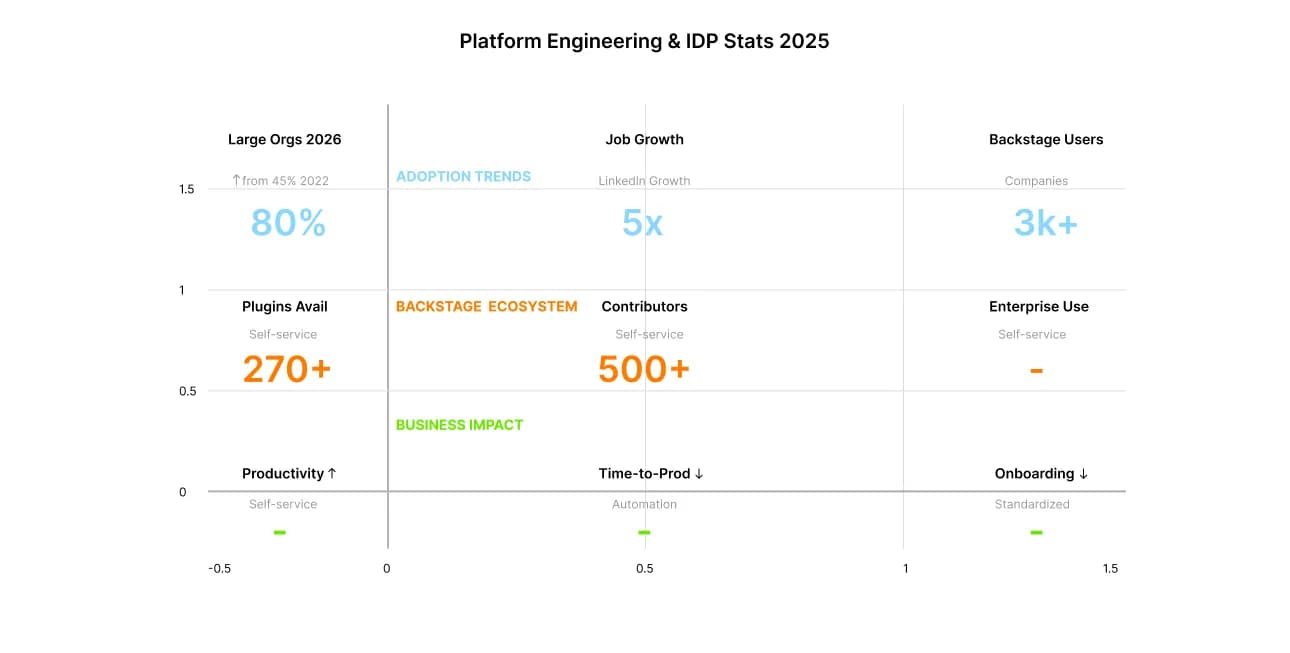Back
Updated at: October 18, 2025
Platform Engineering Revolution: How Internal Developer Portals are Transforming Enterprise Development in 2025

2025 has seen a significant turning point in the software development landscape, with platform engineering taking the lead in handling intricate cloud-native systems.
Compared to just 45% in 2022, 80% of big software engineering firms will have dedicated platform engineering teams functioning as internal providers of reusable services, components, and tools by 2026.
This represents not just a trend but a fundamental transformation in how enterprises approach developer productivity, operational efficiency, and software delivery at scale.

Platform Engineering & IDP Adoption Statistics 2025: Market Growth and Enterprise Impact
At the center of this evolution are Internal Developer Portals (IDPs). Platforms like Backstage are now adopted by more than 3,000 companies worldwide, supported by a thriving ecosystem of over 270 plugins. This explosive growth highlights the shift from traditional DevOps to a “Platform as a Product” mindset — creating self-service environments that reduce cognitive load for developers while maintaining strong governance and security standards.
The Market Transformation: From DevOps to Platform-as-Product
Evolution happened in stages:
- The first wave is classic DevOps: build and deployment automation, CI/CD, Infrastructure as Code. This allowed teams to release software faster, but it didn't solve the problem of tool fragmentation.
- The second wave is cloud-native architectures and the mass adoption of containers and Kubernetes. Companies gained flexibility and scalability, but along with that came an increase in infrastructure management complexity.
- The third wave is the transition to platform engineering: platform teams create internal solutions for developers that combine best practices and simplify access to infrastructure.
In this logic, the concept of Platform-as-Product emerges. The platform is no longer considered an "invisible" part of the infrastructure. It becomes an independent product within the company, with its own users (developers), value (accelerated development and improved quality), metrics (time-to-market, DORA), and even marketing (internal promotion of the platform's capabilities).
It is in this context that Internal Developer Portals play the role of a "single pane of glass" for engineers. They simplify working with infrastructure, hide technical complexity, and ensure process standardization.
The Backstage Phenomenon
When it comes to Internal Developer Portals, the first name that comes to mind is Backstage. Originally developed at Spotify and later donated to the CNCF, this tool has become the de facto standard in the IDP space.
Backstage solves several key tasks:
- provides a Service Catalog to help developers navigate the many services and components;
- standardizes the process of creating new projects through Software Templates;
- supports integration with a wide range of DevOps tools and cloud services;
- offers a powerful ecosystem of plugins to extend functionality for specific needs.
Unsurprisingly, Backstage has become a symbol of the new era in platform engineering. However, with growing adoption, its limitations have also become clear: high implementation and maintenance costs, the need for a dedicated team for customization, and hidden total cost of ownership (TCO).
Comparison: Backstage vs Alternatives
To understand Backstage's place in the market, it's helpful to compare it to alternative solutions.
|
Platform |
Strengths |
Weaknesses |
Best fit for |
|
Backstage (Spotify, CNCF) |
Open-source, large plugin ecosystem, strong community, highly customizable. |
Requires significant engineering effort; steep learning curve; hidden TCO. |
Large organizations with a dedicated platform engineering team. |
|
Enterprise-ready, strong CI/CD integration, RBAC, audit trail, analytics; managed SaaS/hybrid deployment. |
Less flexible than open-source; vendor lock-in risk. |
Enterprises prioritizing security, compliance, and low operational overhead. | |
|
Ready-to-use IDP, multi-cloud management, FinOps/GreenOps features, polished UI/UX. |
Less customizable; smaller community. |
Enterprises seeking fast deployment and cost visibility. | |
|
Intuitive interface, easy onboarding, flexible integrations, strong dashboards. |
Fewer enterprise-grade controls compared to Backstage. |
Mid-size teams needing a lightweight IDP without heavy maintenance. |
Expert Commentary: Choosing the Right IDP
The choice between Backstage and alternatives depends on a company’s maturity and resources:
- Large enterprises with strong platform engineering teams benefit from Backstage’s flexibility but must be ready to invest in customization.
- Highly regulated industries prefer Harness, offering governance and compliance features out of the box.
- Mid-size organizations value Cycloid’s quick setup and cost transparency.
- Smaller or scaling teams may choose Port for its simplicity and faster time-to-value.
In practice, many companies adopt a hybrid approach: starting with lightweight solutions for quick wins, then transitioning to more powerful platforms like Backstage as they mature.
Architectural Practices and Patterns
Implementing Internal Developer Portals (IDPs) is not only about providing a convenient interface. The foundation lies in architectural practices that make the platform scalable, secure, and adaptable to change.
1. Service Catalog as the Foundation
Every IDP starts with a Service Catalog – a registry of all services and components within the company. It ensures:
- transparency: developers know what already exists and can reuse services;
- standardization: each service is described by the same rules, including SLA, dependencies, and ownership;
- faster onboarding for new employees, reducing time to their first productive task.
2. Templates and Process Standardization
Software Templates automate routine tasks such as:
- creating a new microservice;
- setting up a CI/CD pipeline;
- enabling monitoring and logging.
Instead of reinventing the wheel, teams use proven templates, increasing both speed and quality.
3. Policy-as-Code
Modern portals increasingly adopt Policy-as-Code. Rules and policies are defined as code and automatically applied across all services. This approach reduces human error risk and guarantees a consistent level of security and compliance.
4. Observability and Developer Experience
IDPs are evolving into not only entry points for developers but also monitoring tools. Integrations with observability platforms allow teams to track the health of services directly within the portal. This improves Developer Experience (DevEx) and reduces incident resolution time.
5. GitOps as an Architectural Pattern
The growing adoption of GitOps makes IDPs even more powerful. In this model, the portal acts as the interface, while all infrastructure changes are tracked in Git and applied automatically. This provides:
- transparency of changes;
- automated rollback capabilities;
- predictable infrastructure state.
Real-World Use Cases
Although Internal Developer Portals (IDPs) are still a relatively young category, they are already widely adopted across industries. Their impact is most visible in sectors where speed, quality, and compliance are critical.
Financial Services
Banks and fintech companies use IDPs to:
- enforce strict access controls to infrastructure and services;
- accelerate delivery of new digital products (mobile apps, online banking);
- ensure regulatory compliance with centralized documentation and transparent processes.
Result: faster time-to-market for new features without compromising security.
Telecommunications
Telecom providers leverage IDPs to manage network infrastructure and deploy 5G services. Portals help:
- standardize processes;
- scale services more efficiently;
- reduce configuration errors.
Result: improved network reliability and faster rollout of new services to millions of users.
E-commerce and Digital Platforms
For online retailers and platforms, high availability and rapid feature releases are critical. With IDPs, companies can:
- automate microservice creation;
- manage infrastructure for peak loads (e.g., Black Friday);
- accelerate testing and deployment of new functionality.
Result: better customer experience and increased conversion rates due to reliable platform performance.
Public Sector
Governments adopt IDPs as part of digital public services platforms to:
- ensure transparency and accountability;
- protect sensitive citizen data;
- simplify the management of large numbers of services.
Result: higher public trust and more efficient use of taxpayer budgets.
The AI Dimension
The integration of Artificial Intelligence (AI) marks the next stage in the evolution of Internal Developer Portals (IDPs). While today portals primarily automate infrastructure access and tool orchestration, with AI they begin to function as intelligent assistants for developers.
1. Intelligent Recommendations
AI models can analyze change history, performance metrics, and incident data to suggest:
- optimal templates for new services;
- best-practice configurations;
- forecasts of potential bottlenecks in architecture.
2. Automated Troubleshooting
AI-enhanced IDPs can go beyond alerts and provide actionable solutions:
- triggering automated rollbacks;
- analyzing logs to pinpoint root causes;
- recommending CI/CD pipeline adjustments.
3. Natural Language Interfaces
With the integration of LLMs (Large Language Models), IDPs can support natural language queries. For example:
- “Show me all services with expired SLAs.”
- “Create a new Go microservice with monitoring enabled.”
The portal interprets the request and executes the required tasks.
4. Continuous Learning
The longer an IDP uses AI, the smarter it becomes. The system continuously learns from real-world team data, adapting to an organization’s culture and priorities.
In the future, AI may transform IDPs into full-fledged virtual platform engineers, automating not just repetitive tasks but also proactively driving business value by improving reliability and accelerating innovation.
Measuring Success: DORA Metrics and Business KPIs
Adopting Internal Developer Portals (IDPs) makes sense only if it delivers measurable outcomes. Organizations therefore increasingly rely on a combination of technical metrics (e.g., DORA) and business KPIs.
DORA Metrics Excellence
Research shows that organizations adopting IDPs and GitOps practices achieve substantially better results across all four DORA metrics:
- Deployment Frequency — IDP/GitOps-enabled teams average 8.5 deployments per day compared to 2.1 for traditional teams (+305% velocity).
- Lead Time for Changes — average time from commit to production drops to 2.3 hours versus 18.5 hours (-87% delivery time).
- Change Failure Rate — failed changes fall to 8% versus 24% (+67% reliability).
- Mean Time to Recovery (MTTR) — recovery time after incidents shrinks to 0.8 hours compared to 4.2 hours (-81% faster recovery).
These improvements clearly show that IDPs are not just about developer convenience but about driving quality, resilience, and operational excellence.
Business KPIs
In addition to engineering outcomes, IDPs significantly improve business performance by impacting:
- Time-to-Market — faster delivery of new features.
- Cost Efficiency — reduced infrastructure overhead and fewer costly incidents.
- Developer Productivity — improved workflows and less reliance on platform teams.
- Customer Satisfaction — more stable, reliable products strengthen trust.
- Compliance Readiness — transparent processes ease audits and regulatory alignment.
Thus, the success of IDPs is measured not only by automated processes but also by their contribution to strategic business goals.
Future Outlook and Strategic Recommendations
The Future of Internal Developer Portals
By 2030, Internal Developer Portals (IDPs) are expected to become a standard for all organizations working in cloud-native and platform engineering environments. Analysts predict that IDPs will occupy a role similar to what DevOps held in the last decade — moving from an innovator’s practice to a mainstream enterprise standard.
Key trends to watch:
- AI-first IDPs — where Artificial Intelligence is embedded in the core of portals, enabling intelligent recommendations, incident analysis, and process optimization.
- Multi-cloud unification — IDPs will act as the single layer of control for hybrid and multi-cloud strategies.
- Security and compliance by default — deeper integration with DevSecOps practices, automated policy checks, and regulatory compliance.
- Focus on Developer Experience (DevEx) — the main KPI will shift to developer satisfaction and reduced time-to-productivity.
Strategic Recommendations for Enterprises
- Start with developer needs. An IDP must solve real pains for engineering teams, not just serve as a showcase.
- Set measurable goals. Use DORA metrics and business KPIs to evaluate progress.
- Align IDP strategy with organizational maturity.
- Startups and mid-sized firms: adopt lightweight solutions like Port or Cycloid for fast wins.
- Enterprises with complex requirements: invest in Backstage or Harness IDP for maximum flexibility and compliance.
- Invest in platform teams. Tools alone are not enough — building an IDP requires a strong platform engineering culture.
- Design for the future. Build IDPs with extensibility in mind — enabling integration of AI modules, observability tools, and new cloud-native technologies.
Conclusion: Platform Engineering as Strategic Infrastructure
The adoption of platform engineering and Internal Developer Portals signals more than a technological evolution — it represents a strategic shift in how enterprises create, scale, and deliver software value. Organizations that embrace a platform-as-product mindset and invest in developer experience are setting the foundation for sustained competitive advantage through faster innovation, greater operational efficiency, and higher team satisfaction.
The window of opportunity is narrowing. With 80% of large enterprises projected to establish platform engineering teams by 2026, early adopters will benefit from proven practices, stronger ecosystems, and established talent pools. Those that wait risk accumulating technical debt, struggling with fragmented processes, and falling behind more agile competitors.
Success in platform engineering requires long-term commitment: treating platforms as products, fostering self-service automation, and balancing developer autonomy with governance, security, and compliance. The most successful organizations will not only reduce cognitive load but also empower teams to innovate faster and with confidence.
In a world where software defines business outcomes, platform engineering is no longer optional — it is strategic infrastructure. Enterprises that make this investment today will compound benefits in productivity, agility, and resilience, positioning themselves as leaders in the increasingly software-driven economy.
Summary:
The landscape of software development is undergoing a significant transformation, largely driven by platform engineering and the adoption of Internal Developer Portals (IDPs). By a future date, a substantial percentage of large software engineering firms are anticipated to establish dedicated platform engineering teams that focus on providing reusable services and tools. IDPs, particularly those like Backstage, have gained traction among companies, showcasing a shift towards a "Platform as a Product" approach that enhances developer productivity while maintaining governance and security. The evolution from traditional DevOps to platform engineering has been marked by increased automation and simplification of infrastructure management, with IDPs serving as centralized interfaces for developers. Backstage stands out in the IDP market due to its open-source nature and extensive plugin ecosystem, though it also presents challenges such as high implementation costs and a steep learning curve. Various alternatives to Backstage cater to different organizational needs, emphasizing that the choice of an IDP should align with a company’s maturity and resources. The implementation of IDPs is not merely about convenience; it is focused on measurable outcomes in terms of development metrics and business performance indicators. The integration of AI into IDPs is poised to further enhance their capabilities, enabling intelligent recommendations and automated troubleshooting. As organizations increasingly rely on IDPs, the focus is shifting towards improving developer experience and achieving operational excellence. Ultimately, investing in platform engineering and IDPs is becoming essential for enterprises to maintain a competitive edge in a software-driven economy.
Read also:
platformengineering
internaldeveloperportals
IDPs
Backstage
DevOps
cloudnative
Kubernetes
AIinsoftware
softwaredevelopment2025
developerproductivity
operationalexcellence
DORAmetrics
GitOps
softwareinnovation
enterprisetechnology
cloudcomputing
trends2025
platformasaproduct
developerexperience
softwaredelivery




